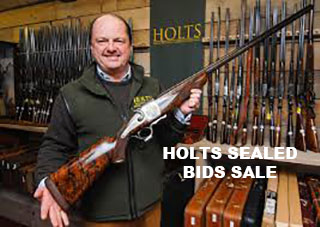Auctions are becoming a retail environment. It has long been asserted that this is the case by many old hands in the trade. In fact, arguably, the tipping point was reached some time ago. I no longer see some of the old regulars at the auctions, they simply don’t provide the stream of stock that dealers once relied upon.
One well-established dealer in vintage guns, who was a former auction regular, told me auctions are now a waste of his time, as a trip to London hardly ever resulted in useful buying. Another, the proprietor of a large and successful provincial gun shop, confided that he now sits on any auction purchase for twelve months, at least, before offering it for sale.
The reason is the internet-search function available to, and employed by, so many prospective purchasers. A few minutes looking through the history of a gun’s recent sales activity reveal that it was bought at auction for, say, £500 and is now for sale, a few months later, for £1,100. Savvy as they may be, people are one-eyed when it comes to processing this information. They see the hammer price, neglect to add the commission, VAT and the cost of renovation and they begrudge the trader any profit at all. Such an arena makes trade difficult.
So, where are all the guns going? In my experience there are now three main types of buyer: The foreign gun shop owner, the private collector or retail end-user and, finally, the dealer acting directly on behalf of an individual client.
Holts have come to dominate the market.
The overseas gun shop may be able to operate in an environment sufficiently remote from the London auctions for their client-base to either not be in a position to do English-language searches of a history, or, more forgiving or accepting of the costs of gathering stock in another country and importing it in preparation for a sale.
The private collector or end-user either sources guns through auction because the rare or unique pieces that headline often offer one-off opportunities to buy, or because they think that they will under-cut the dealers and get a bargain. The dealer acting on behalf of client is usually the ‘wise head’ who can advise the enthusiast and help ensure that he does not buy rashly and make a poor decision. We also have collectors who prefer to remain aloof and anonymous and have ‘their man’ act for them.
The buyer at most risk of running into trouble is the private individual seeking a bargain. ‘Penny-wise, pound-foolish’ may be a cliche but it is so often observable in the auction room that it has changed the market.
So, just what is it that the casual buyer overlooks when picking up a gun that has arrived in the auction from the gun cabinet of a retiring shooter? Such guns typically have not been cleaned for decades. They look tired and perhaps a bit grubby but offer he fabled ‘bargain’ and in rush the fools.
The estimates are enticing and the bidding moves upwards, the bidder goes with the room and ends up buying over top estimate. Still, he tells himself, it is a quality gun and it must be worth it because someone else was bidding strongly on it too. Then he goes to the office to pay and takes a big swallow when he actually sees the calculation of commission and VAT. When it adds close to 30% to the hammer price, it starts to look like less of a bargain.
Still, what’s done is done, the gun goes home with the buyer. What happens next can be a quick turnaround. I saw a Greener 28-bore single barrel gun in Holt’s March sale, which had been in the previous sale and sold. The buyer had bought it blind, taken it home, found he missed the barn door from inside the barn and decided it had to go! So, back in again, Holt’s were, doubtless, pleased to bag 30% of the sale price twice in succession on the same gun.
I would never buy without inspecting a gun carefully first.
If not returned or chucked in the safe and forgotten, the gun will generally be in need of some work, which will rarely have been costed in at the time of purchase. Re- blacking the barrels will cost our hero £250, a strip, clean and service of a boxlock ejector might run him up another £150. While there, the gunsmith tells him it is off the face and needs re- jointing, another £350 please. And did you notice the rib was leaking when we re-blacked it, we had to re-lay it; another £350. Once you are in, you have to keep going. With so much spent already, the gun looks a bit odd with nice barrels and worn chequer and dull wood, so, put it right, another £500.
The £1,000 bid has turned into a bit of a money pit; with the actual price paid being £1,300 and repairs running up a total of £2,900 in the gun. This is actually closer to the retail value that you would have had to pay in a shop, which would have done the work on trade terms, added a serviceability guarantee and peace of mind and made a small profit. Trying to get this reality into the mind of the auction amateur is a real trial. All they see is the headline figure.
A professional acting for client can save him all of these headaches and can make end-user purchases worthwhile. He will be able to advise as to what work is necessary and how much it will cost. He will be able to have the work done well at trade prices and provide the customer with the gun post-refurbishment, with length and cast adjustments properly worked out and delivered accurately. This way, a project can be planned and costed before the bidding begins, it will make the customer see the true worth of the gun in both project start and retail finish terms.
One must always remember when bidding at auction that you cannot bid against stupid. The fact that someone else is bidding strongly is just as likely to be an indication of his ignorance of the gun’s problems as it is of his appreciation of its qualities and value.
Published by Vintage Guns Ltd on (modified )




